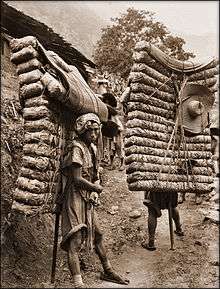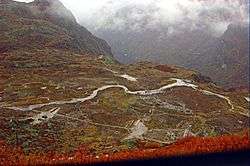Tea Horse Road



The Tea Horse Road or chamada (simplified Chinese: 茶马道; traditional Chinese: 茶馬道), now generally referred to as the Ancient Tea Horse Road or chamada (simplified Chinese: 茶马古道; traditional Chinese: 茶馬古道) was a network of caravan paths winding through the mountains of Sichuan, Yunnan and Guizhou in Southwest China.[1] It is also sometimes referred to as the Southern Silk Road. The route extended to Bengal in South Asia.
History
From around a thousand years ago, the Ancient Tea Route was a trade link from Yunnan, one of the first tea-producing regions: to Bengal via Burma; to Tibet; and to central China via Sichuan Province.[2][3][4][5][6] In addition to tea, the mule caravans carried salt. Both people and horses carried heavy loads, the tea porters sometimes carrying over 60–90 kg, which was often more than their own body weight in tea.[7][8][9]
It is believed that it was through this trading network that tea (typically tea bricks) first spread across China and Asia from its origins in Pu'er county, near Simao Prefecture in Yunnan.[10][11]
The route earned the name Tea-Horse Road because of the common trade of Tibetan ponies for Chinese tea, a practice dating back at least to the Song dynasty, when the sturdy horses were important for China to fight warring nomads in the north.[12]
Future
In the 21st century, the legacy of the Tea-Horse Road has been used to promote a railway that will connect Chengdu to Lhasa. This planned railroad, part of the PRC's 13th 5-Year Plan, is called the 川藏铁路; it will connect cities across the route including Kangding. Authorities claim it will bring great benefit to the people's welfare.[13]
See also
- Tea
- Pu-erh tea
- Shaxi, Yunnan, a well-preserved historical trading town in Jianchuan County on the ancient tea route
- Siberian Route
- Silk Road
- Jeff Fuchs, the first westerner to walk the entire road
References
- ↑ Forbes, Andrew, and Henley, David: Traders of the Golden Triangle (A study of the traditional Yunnanese mule caravan trade). Chiang Mai. Cognoscenti Books, 2011.
- ↑ "Horse Corridor in Heaven". Shambhalatimes.org. 2010-01-18. Retrieved 2011-11-18.
- ↑ "Tea-Horse Route". Chinatrekking.com. Retrieved 2011-11-18.
- ↑ "The road line of the ancient tea-and-horse trade road". Yellowsheepriver.com. Retrieved 2011-11-18.
- ↑ "Richness, Diversity and Natural Beauty on the Tea Horse Road". English.cri.cn. Retrieved 2011-11-18.
- ↑ "Strange Brew:The Story of Puer Tea 普洱茶". Retrieved 2011-11-28.
- ↑ "Between Winds and Clouds: Chapter 2". Gutenberg-e.org. 2007-12-04. Retrieved 2014-08-22.
- ↑ "Holiday". Weeklyholiday.net. Retrieved 2014-08-22.
- ↑ "History and Legend of Sino-Bangla Contacts". Bd.china-embassy.org. Retrieved 2015-05-19.
- ↑ Jeff Fuchs. The Ancient Tea Horse Road: Travels with the Last of the Himalayan Muleteers, Viking Canada, 2008. ISBN 978-0-670-06611-7
- ↑ Forbes, Andrew, and Henley, David, 'Pu'er Tea Traditions' in: China's Ancient Tea Horse Road. Chiang Mai, Cognoscenti Books, 2011.
- ↑ Jenkins, Mark (May 2010). "The Tea Horse Road". National Geographic.
- ↑ http://news.cntv.cn/2015/08/13/ARTI1439458357250340.shtml
Further reading
- Forbes, Andrew ; Henley, David (2011). China's Ancient Tea Horse Road. Chiang Mai: Cognoscenti Books. ASIN B005DQV7Q2
- Forbes, Andrew ; Henley, David (2011). Traders of the Golden Triangle. Chiang Mai: Cognoscenti Books. ASIN B006GMID5
- Freeman, Michael; Ahmed, Selena (2011). Tea Horse Road: China’s Ancient Trade Road to Tibet. Bangkok: River Books Co, Ltd. ISBN 978-974-9863-93-0.
External links
| Wikimedia Commons has media related to Ancient tea route. |
- Silk Road Foundation - An authoritative article about the ancient tea route by Yang Fuquan, director of the Yunnan Academy of Social Sciences.
- Documentary: Insight on Asia - Asian Corridor in Heaven - Made by KBS. TV Program.
- Tea Horse Road - National Geographic Magazine
- "The Tea Horse Road", Jeff Fuchs, The Silk Road, Vol.6, No.1 (Winter 2008).
- Interview: Jeff Fuchs, Gokunming, August 11, 2010.
- Bob Rogers and Claire Rogers, "Traveling Today's Tea Horse Road", Desert Leaf magazine, February 2011.

